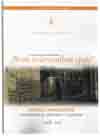Wczesnośredniowieczna broń obuchowa z terenu Polski w dorobku Andrzeja Nadolskiego z perspektywy kolejnych lat badań
Early medieval blunt weapon from the territory of Poland in Andrzej Nadolski’s studies, from the perspective of further years of research
Author(s): Piotr N. Kotowicz, Arkadiusz MichalakSubject(s): Archaeology
Published by: Łódzkie Towarzystwo Naukowe
Keywords: wczesne średniowiecze; archeologia; bronioznawstwo; broń obuchowa
Summary/Abstract: Andrzej Nadolski is regarded as one of the most distinguished arms and armor specialist in Europe. Studies over Polish weaponry taken just after World War II provided in 1954 a first in our continent monograph in this subject. Much contribution in this work was done in the field of knowing early medieval blunt weapon – hammer axes, battle axes and maces. Studies of early medieval arms and armor, taken by A. Nadolski, were a huge challenge, also because he included sparse information from the written, iconographic as well ethnological and linguistic sources. The main contribution of this research was however typo-chronological classification of collection of 172 hammer- and battle axes from the territory of Piast state. This system, used by Author in all of his further works, was widely accepted by many Polish archeologists, and is being employed, sometimes uncritically, until today. Due to the fact that the total number of known artefacts increase a lot (Fig. 1), and this classification cannot be developed, it seems that it is not possible to use this typology to all known materials from the territory of Poland. In the consequence of only 5 known artefacts, Author did not propose any classification for maces. From that time, known number of this kind of objects increased almost 10 times (Fig. 2), but most of them are chance finds, without any proper archeological context. Besides typo-chronological aspects, Author discussed also many other problems concerning this kind of weapon, including the presence of small holes in the axe and hammer-axe heads, their decoration, length of the shafts, distribution of particular forms. Nadolski demystify also claims of German researchers, who treated many forms of axes as so-called „Viking”, but having in fact their roots in the territory of Central Europe, and could have been produced by local blacksmiths, what was proven by metallographic examinations. Last years caused increase of interest also in the field of mace manufacturing, especially in technological context. This survey showed enormous meaning of Nadolski’s monograph for Polish arms and armour studies, and some ideas were developed also in further papers – eg. in the article concerned of symbolic destination of clubs. However, state of research caused that many aspects of blunt weapon was, for scholar from Łódź, unavailable. In case of all categories of blunt weapon a major step forward was made recently, thanks to the increase of number of known artefacts, as well as development of research in the neighboring countries. During the archaeological excavations conducted in the last 60-years, large collections of this kind of weapon were obtained, sometimes, like in the case of water finds, preserved in whole. This fact encouraged scholars for detailed specialist analysis.
Journal: Acta Archaeologica Lodziensia
- Issue Year: 2013
- Issue No: 59
- Page Range: 47-62
- Page Count: 16
- Language: Polish

